Papers by Maria Luisa Ruiz-Gálvez
Complutum
El texto desarrolla el modelo de las diásporas comerciales como alternativa a la precolonización ... more El texto desarrolla el modelo de las diásporas comerciales como alternativa a la precolonización en el Bronce Final y plantea la existencia de agentes foráneos conviviendo entre indígenas en el Centro y Oeste del Mediterráneo antes de la implantación de las colonias históricas.
Complutum, 2023
Resumen. El texto desarrolla el modelo de las diásporas comerciales como alternativa a la precolo... more Resumen. El texto desarrolla el modelo de las diásporas comerciales como alternativa a la precolonización en el Bronce Final y plantea la existencia de agentes foráneos conviviendo entre indígenas en el Centro y Oeste del Mediterráneo antes de la implantación de las colonias históricas Palabras clave: banquete; heroización; micénico; chipriota; fenicio.
Boletín de la Sociedad Española de Cerámica y Vidrio
Cerámica y Vidrio, 2022
Please cite this article in press as: M. García-Heras, et al., Archaeometric characterization of ... more Please cite this article in press as: M. García-Heras, et al., Archaeometric characterization of glass and a carnelian bead to study trade networks of two Swahili sites from the Ibo Island (Northern Mozambique), Bol. Soc. Esp. Cerám. Vidr.
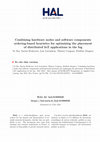
As fog computing brings compute and storage resources to the edge of the network, there is an inc... more As fog computing brings compute and storage resources to the edge of the network, there is an increasing need for automated placement (i.e., selection of hosting devices) to deploy distributed applications. Such a placement must conform to applications' resource requirements in a heterogeneous fog infrastructure. The placement decision-making is further complicated by Internet of Things (IoT) applications that are tied to geographical locations of physical objects/things. This paper presents a model, an objective function, and a mechanism to address the problem of placing distributed IoT applications in the fog. Based on a backtrack search algorithm and accompanied heuristics, the proposed mechanism is able to deal with large scale problems, and to efficiently make placement decisions that fit the objective-to lower placed applications' response time. The proposed approach is validated through comparative simulations of different combinations of the algorithms and heuristics on varying sizes of infrastructures and applications. CCS CONCEPTS • Software and its engineering → Distributed systems organizing principles;
Information collected during our 2015 to 2017 field campaign in the Quirimbas archipelago on the ... more Information collected during our 2015 to 2017 field campaign in the Quirimbas archipelago on the frame of the research Project “Swahili trade in Northern Mozambique”, prove their early and decisive role played in the Indian ocean trade.
Journal of Archaeological Science: Reports, 2021
Abstract In this paper we discuss the results of the archaeometric study (OM, SEM-EDS and PIXE) o... more Abstract In this paper we discuss the results of the archaeometric study (OM, SEM-EDS and PIXE) of a gold bead recovered within an archaeological research program undertaken at Ibo island (Quirimbas archipelago, Northern Mozambique), and its significance in the historical regional context. Our aim is to fill the gap in our knowledge of the role played by the Northern Mozambican shore on the trade networks linking the Eastern African and the rest of the Indian Ocean.
espanolEl articulo resume los principales resultados de la primera campana de excavaciones en la ... more espanolEl articulo resume los principales resultados de la primera campana de excavaciones en la isla de Ibo (archipielago de las Quirimbas, Mozambique), desarrollada en junio de 2016. La excavacion de cuatro sondeos en la zona central del pueblo ha permitido documentar un conjunto muy significativo de materiales arqueologicos de epoca portuguesa y Swahili, asi como un suelo de ocupacion antiguo, posiblemente entre los siglos XII y XV. EnglishThe article summarizes the main results of the first fieldwork season at Ibo Island (Quirimbas, archipelago, Mozambique), conducted during June 2016. The excavation of for different areas in the central part of the village has documented a remarkable sample of archaeological materials, as well as an occupation level of still undetermined but most likely ancient chronology.
African Archaeological Review, 2021

Journal of World Prehistory, 2016
House societies have become popular with archaeologists in recent years, due to (among other thin... more House societies have become popular with archaeologists in recent years, due to (among other things) their conspicuous material basis (wealth, heirlooms and the houses themselves). As yet, however, most archaeological studies have focused only on individual societies. In this article, we offer a comparative and long-term approach to the phenomenon, using as case studies the Bronze Age and Iron Age communities of the Levant, the Aegean and the central Mediterranean. We describe the elements that define them as house societies and examine their evolution through time. We follow a strictly Lévi-Straussian definition of the house that prevents the concept from losing heuristic power. Using this definition, we consider that houses are to be found in ranked societies without centralization and in complex agropastoral systems, like those of the Mediterranean, where agricultural soil is scarce and liable to be monopolized. We argue that the house emerges in these competitive contexts as an institution to control land and retain patrimony undivided. Through a combination of archaeological and written sources, we try to demonstrate that it is possible to document several strategies used by house societies to acquire and retain power and wealth, including dowry, levirate, a bilateral system of marriage alliances, ancestor cults, specific architectures and house treasures. The case studies addressed here offer good comparative material for assessing similar processes elsewhere. At the same time, we argue that the Mediterranean area developed a particular ideology, that of the shepherd ruler, that was essential to legitimate the house.
Complutum, 2015
The text describes the excavations undertaken in different sites of the valley. The reasons for t... more The text describes the excavations undertaken in different sites of the valley. The reasons for their choice and the results obtained. Seventeen sites were tested, either burial mounds or shelters. We can contextualize the human presence in the valley at different time periods: Late Neolithic, Late Neolithic-Copper Age, Bronze Age and Middle Ages. Also, and despite the plundering, some interesting features regarding the tumuli could be observed through excavation.
Trabajos de Prehistoria, 2003
ANTONIO RUBINOS (*) MARISA RUIZ-GÁLVEZ (**) RESUMEN La obtención por parte del Proyecto Pranemuru... more ANTONIO RUBINOS (*) MARISA RUIZ-GÁLVEZ (**) RESUMEN La obtención por parte del Proyecto Pranemuru de cerca de una veintena de dataciones radiocarbónicas para una microregión en época nurágica, de las que aquí se recogen y discuten catorce, abre la posibilidad de revisar la cronología de la Edad del Bronce en Cerdeña, a la luz de las dataciones recogidas desde los años 90 por Trump (1990) y Tykot (1994) y, más recientemente, por Webster (2001), discutir la validez de las fechas en función de los criterios de recogida de muestra, contexto arqueológico, desviación estándar y forma en que ha sido publicada, así como contrastarla con la cronología propuesta recientemente para la Protohistoria sarda, de acuerdo con la Dendrocronología y Cronología Radiocarbónica para la Italia peninsular (Lo Schiavo 2002).
... Información General. Autores: Marisa Ruiz-Gálvez Priego ( coord. ... Listado de artículos. Nu... more ... Información General. Autores: Marisa Ruiz-Gálvez Priego ( coord. ... Listado de artículos. Nuragic territory and ancient landscape: the Pranemuru Plateau (Sardinia) during the Bronze Age.Marisa Ruiz-Gálvez Priego. págs. 19-26. Prospección y sondeos. ...
… (15-16 de enero de 1996 …, 2001
Información del artículo Rutas ganaderas, transterminancia y caminos antiguos: el caso del Occide... more Información del artículo Rutas ganaderas, transterminancia y caminos antiguos: el caso del Occidente peninsular entre el Calcolítico y la Edad del Hierro.
… cultural entre el Mediterráneo y el …, 2008
... Núria Rafel i Fontanals ( aut. ), Xosé Lois Armada Pita ( aut. ), 2008, ISBN 978-84-00-08689-... more ... Núria Rafel i Fontanals ( aut. ), Xosé Lois Armada Pita ( aut. ), 2008, ISBN 978-84-00-08689-3 , págs. 27-40. Fundación Dialnet. Acceso de usuarios registrados. Acceso de usuarios registrados Usuario. Contraseña. Entrar. Mi Dialnet. ...
… of Metals in Bronze Age Europe. Proceedings of a …, 2000
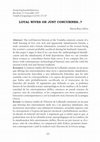
Treballs d'Arqueologia, 2007
The well known Heroon at the Toumba cemetery consist of a shaft housing of two very rich and appa... more The well known Heroon at the Toumba cemetery consist of a shaft housing of two very rich and apparently simultaneous burials, a male cremation and a female inhumation, assumed as the woman being the warrior's consort probably sacrificed during his husband's funerals. In this paper I argue is that if we can trust the anthropological identification and the simultaneity of both depositions, then we can consider these women as concubines better than wives, if we compare this evidence with contemporary archaeological funerary sites and the with the ancient Greek oral and literary tradition. Resumen: La famosa tumba del Heroon de Lefkandi consiste en un pozo que alberga dos enterramientos muy ricos y aparentemente simultáneos, una incineración masculina y una inhumación femenina, que ha sido asumida como la correspondiente a la esposa del guerrero incinerado y que había sido probablemente sacrificada en el transcurso de los funerales del marido. El argumento que defiendo es que, si podemos fiarnos de las identificaciones antropológicas de las tumbas y de la simultaneidad de los enterramientos dobles, entonces no puede tratarse de esposas, sino de concubinas, si los comparamos con otros yacimientos funerarios contemporáneos y con la tradición oral y literaria de la antigua Grecia. Resum: La famosa tomba de l'Heroon de Lefkandi consisteix en un pou que hostatja dos enterraments molt rics i en aparença simultanis: una incineració masculina i una inhumació femenina, assumida aquesta com la corresponent a l'esposa del guerrer incinerat i probablement sacrificada durant els funerals del marit. L'argument que es defén aquí és que, si podem finar-nos de les identificacions antropològiques de les tombes i de la simultaneïtat dels enterraments dobles, llavors no pot tractar-se d'esposes, sinó de concubines, en comparació amb d'altres jaciments funeraris contemporanis i amb la tradició oral i literària de la Grècia antiga.
Ruiz-Gálvez, M., Bokbot, Y., Collado, H., ElGraoui, M., Farjas, M., Galán, E., Lemjidi, A., Nieto... more Ruiz-Gálvez, M., Bokbot, Y., Collado, H., ElGraoui, M., Farjas, M., Galán, E., Lemjidi, A., Nieto, C., de la Presa, P., de Torres, J., Señoran, J.M. 1 Facultad de Geografía e Historia. Departamento de Prehistoria. Universidad Complutense de Madrid 2 INSAP, Rabat 3 Council of Extremadura’s Heritage, Mérida 4 Centre National du Art Rupestre, Marrakech 5 E.T.S.I. Topografía, Geodesia y Cartografía. Universidad Politécnica de Madrid 6 Archaeological National Museum, Madrid 7 Incipit. CSIC. Santiago de Compostela marisar.gp@ghis.ucm.es, hipolitocollado@gmail.com, m.farjas@upm.es, eduardo.galan@mcu.es, idijmel@yahoo.fr, carlos9596@gmail.com, delapresa.topografia@gmail.com, jorgedetorres@ghis.ucm.es, jose.m.senoran@incipit.csic.es
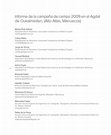
Informes Y Trabajos, 2011
La campaña 2009 en Agdal de Oukaïmeden se ha centrado en diferentes líneas de trabajo: la excavac... more La campaña 2009 en Agdal de Oukaïmeden se ha centrado en diferentes líneas de trabajo: la excavación del Abrigo de los Elefantes o Adbasán, los sondeos realizados en Aguni Nait Warij, las excavaciones realizadas en los túmulos del valle de Oukaimed y el sondeo frente a la estación K-4.14 "Friso de los Elefantes". Todas estas intervenciones han permitido, entre otros hallazgos, determinar cronologías. Por otro lado, la campaña ha incidido en la ejecución de distintos análisis polínicos, se han muestreado un total de 10 perfiles y se han tomado algunas muestras de musgos de los enclaves más significativos. Otra de las líneas de investigación en 2009 se ha dirigido a los procesos de deterioro de los grabados rupestres, proponiéndose recomendaciones de actuación al respecto, y a la intensificación del estudio general de arte rupestre en la zona, lo que ha propiciado nuevos descubrimientos. La campaña se ha completado con el trabajo etnoarqueológico desarrollado en contacto con los pastores del Atlas.

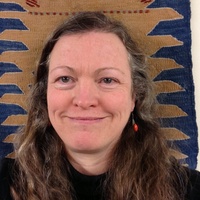








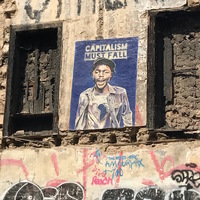
Uploads
Papers by Maria Luisa Ruiz-Gálvez